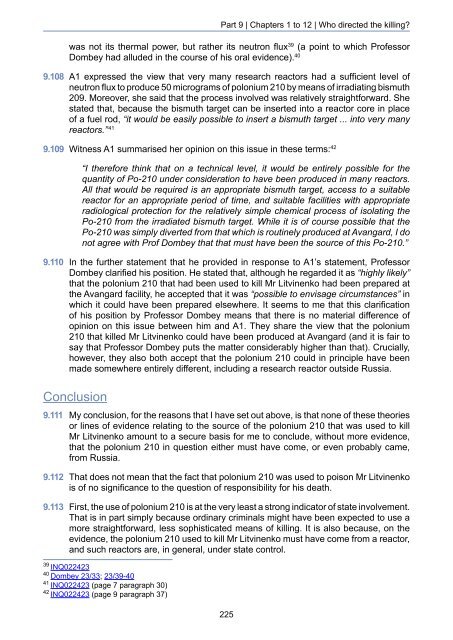The Litvinenko Inquiry
2429870
2429870
You also want an ePaper? Increase the reach of your titles
YUMPU automatically turns print PDFs into web optimized ePapers that Google loves.
Part 9 | Chapters 1 to 12 | Who directed the killing?<br />
was not its thermal power, but rather its neutron flux 39 (a point to which Professor<br />
Dombey had alluded in the course of his oral evidence). 40<br />
9.108 A1 expressed the view that very many research reactors had a sufficient level of<br />
neutron flux to produce 50 micrograms of polonium 210 by means of irradiating bismuth<br />
209. Moreover, she said that the process involved was relatively straightforward. She<br />
stated that, because the bismuth target can be inserted into a reactor core in place<br />
of a fuel rod, “it would be easily possible to insert a bismuth target ... into very many<br />
reactors.” 41<br />
9.109 Witness A1 summarised her opinion on this issue in these terms: 42<br />
“I therefore think that on a technical level, it would be entirely possible for the<br />
quantity of Po-210 under consideration to have been produced in many reactors.<br />
All that would be required is an appropriate bismuth target, access to a suitable<br />
reactor for an appropriate period of time, and suitable facilities with appropriate<br />
radiological protection for the relatively simple chemical process of isolating the<br />
Po-210 from the irradiated bismuth target. While it is of course possible that the<br />
Po-210 was simply diverted from that which is routinely produced at Avangard, I do<br />
not agree with Prof Dombey that that must have been the source of this Po-210.”<br />
9.110 In the further statement that he provided in response to A1’s statement, Professor<br />
Dombey clarified his position. He stated that, although he regarded it as “highly likely”<br />
that the polonium 210 that had been used to kill Mr <strong>Litvinenko</strong> had been prepared at<br />
the Avangard facility, he accepted that it was “possible to envisage circumstances” in<br />
which it could have been prepared elsewhere. It seems to me that this clarification<br />
of his position by Professor Dombey means that there is no material difference of<br />
opinion on this issue between him and A1. <strong>The</strong>y share the view that the polonium<br />
210 that killed Mr <strong>Litvinenko</strong> could have been produced at Avangard (and it is fair to<br />
say that Professor Dombey puts the matter considerably higher than that). Crucially,<br />
however, they also both accept that the polonium 210 could in principle have been<br />
made somewhere entirely different, including a research reactor outside Russia.<br />
Conclusion<br />
9.111 My conclusion, for the reasons that I have set out above, is that none of these theories<br />
or lines of evidence relating to the source of the polonium 210 that was used to kill<br />
Mr <strong>Litvinenko</strong> amount to a secure basis for me to conclude, without more evidence,<br />
that the polonium 210 in question either must have come, or even probably came,<br />
from Russia.<br />
9.112 That does not mean that the fact that polonium 210 was used to poison Mr <strong>Litvinenko</strong><br />
is of no significance to the question of responsibility for his death.<br />
9.113 First, the use of polonium 210 is at the very least a strong indicator of state involvement.<br />
That is in part simply because ordinary criminals might have been expected to use a<br />
more straightforward, less sophisticated means of killing. It is also because, on the<br />
evidence, the polonium 210 used to kill Mr <strong>Litvinenko</strong> must have come from a reactor,<br />
and such reactors are, in general, under state control.<br />
39<br />
INQ022423<br />
40<br />
Dombey 23/33; 23/39-40<br />
41<br />
INQ022423 (page 7 paragraph 30)<br />
42<br />
INQ022423 (page 9 paragraph 37)<br />
225


